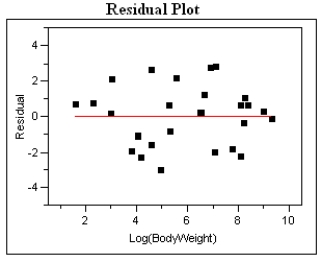Exhibit 4-7
Golden-rumped elephant shrews have long flexible snouts, used to overturn leaf-litter where they find their food: millipedes, insects and spiders. These animals are among the approximately 10% of mammalian species that mate for life. Just why these mammals are monogamous is poorly understood, and one theory is that a monogamous male would have to defend less territory from intrusion by other males. The home range of an animal, i.e. that area over which they typically travel, is a function of diet and energy consumption of the animal. The energy consumption is, in turn, typically a function of the animal's size. In a recent study, investigators reasoned that if monogamy was related in some way to the home territory, this should be detectable by comparing these animals to other insect-eating mammals. Data were gathered on 27 similar species and are presented in the table below.  After fitting a straight line model,
After fitting a straight line model,  , significant curvature was detected in the residual plot, and two transformed models were chosen for further analysis: the power and exponential models. The computer output for these transformed models and the residual plots follow.
, significant curvature was detected in the residual plot, and two transformed models were chosen for further analysis: the power and exponential models. The computer output for these transformed models and the residual plots follow.
Residual Plot and Statistical Analysis - exponential model 
 Log Home Range vs. Weight
Log Home Range vs. Weight
Log(H) = 0.250 + 0.000231 W  Residual Plot and Statistical Analysis - Power model
Residual Plot and Statistical Analysis - Power model 
 Log Home Range vs. Log Weight
Log Home Range vs. Log Weight
Log(H) = −1.601 + 0.893Log(W) 
-Refer to Exhibit 4-7. These shrews typically weigh 550g and their home range is about 2.9 hectares. Using your preferred model from part (c), locate the Golden-rumped elephant shrew on the appropriate residual plot by marking with a small "x." Does your placement of this point suggest the monogamy of these shrews sets them apart from similar species? In a few sentences, explain why or why not.
Definitions:
Marketing Department
A division within a company responsible for developing strategies and tactics to promote, sell, and distribute its products or services.
Environmental Forces
External factors such as social, economic, technological, and political conditions that affect businesses and consumers.
Marketing Occur
The processes or activities undertaken by individuals or organizations to promote, sell, and distribute a product or service.
Desire
A strong feeling of wanting to have something or wishing for something to happen.
Q3: An important part of any dispensing process
Q10: Meteorologists study the climate of Texas. Using
Q11: Assessing the goodness of fit of a
Q19: Suppose a survey was conducted among women
Q23: Pearson's correlation coefficient, r, does not depend
Q30: Black bears (Ursus americanus) have a tendency
Q31: Which of the following is an element
Q41: Health Care Systems, Inc. rolls out an
Q46: The outcomes of a marketer's decisions and
Q108: For an ordinary annuity, the payments are